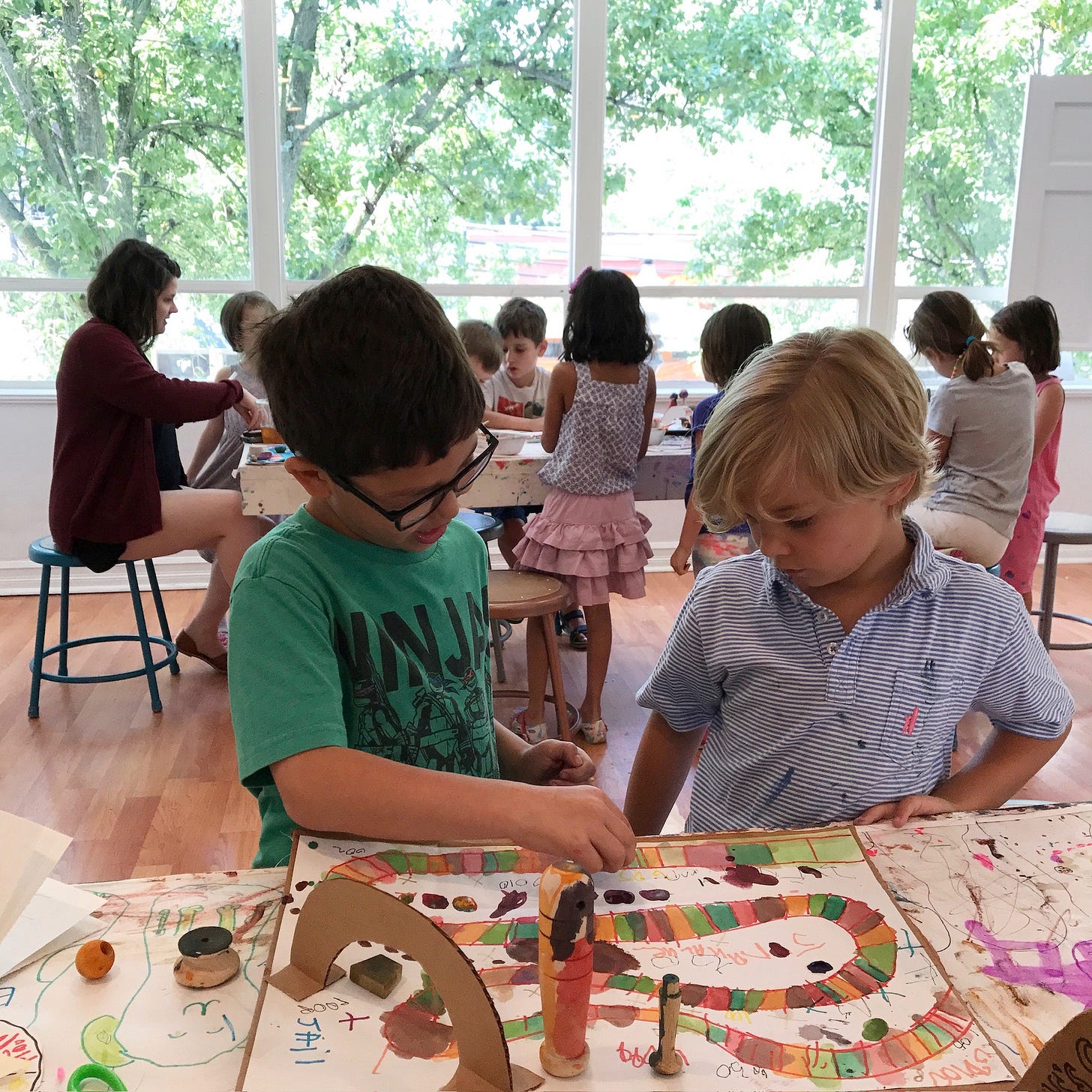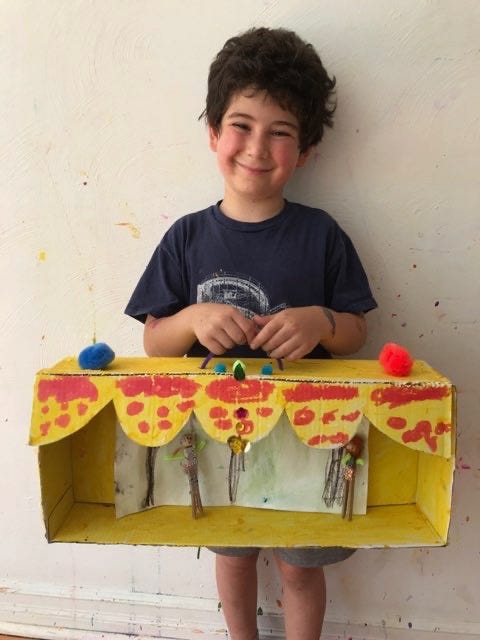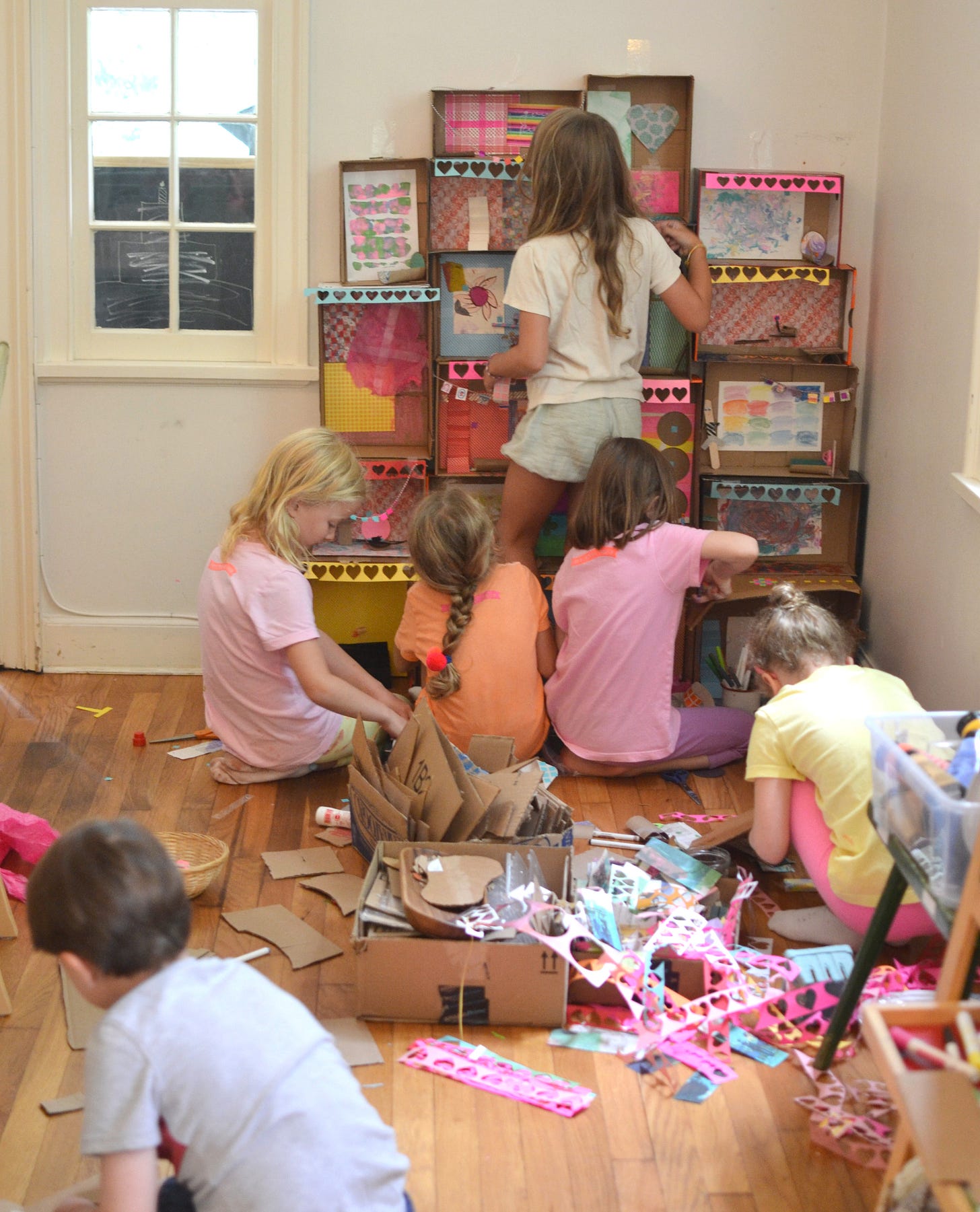Make summer camp meaningful.
What if summer camp were the only chance a child is seen as the most whole version of themselves?
Shannon’s camp vision.
When I started a children’s art and play studio in Pittsburgh in 2015, I knew that summer camp would be an important part of our offerings, but I didn’t know just how important. Since learning about Reggio Emilia 20 years ago, play and creativity have been at the heart of every experience and interaction I’ve had with young children, but summer camp was where I could actually test theories about following the children’s lead, where I created a humane and responsive schedule, and where I was not bound by a bell schedule or the churn of standardized learning. I could build out big, bold ideas that spoke to the 5-9 year old me, like Dollhouse camp and Giant Sculpture camp, into a series of open-ended experiences that utilized a wide range of skills, tools, and materials. I hired educators who wanted to learn more about this approach and contributed their own gifts to the space, like organizing materials, calming nervous children, prepping at warp speed, setting up interesting provocations, and chit-chatting warmly with parents and caregivers.
My vision became reality. Slow mornings with a collage table and a giant bin of sand with thrifted kitchen tools could flow into outdoor play, where children collected sticks and smooth rocks to bring back to the studio. The mornings were energized by the introduction of a project, loose and open-ended, with lots of room for interpretation. A 5-year-old in the group could sit across from a 9-year-old with the same materials and approach the experience completely differently, both from their own unique perspectives. If restlessness set in or a break was needed, it was not a problem, because the children knew they could relax with a book, draw and make messages, squish some clay, or find their own way to play. By the time the afternoon rolled around, it was time to move. We were lucky to be very near a beautiful park with hills for rolling and running, a magical stone wall, and a garden. Or, we would break out the sidewalk chalk and decorate the small business district.

If this sounds idyllic, you’re right, it was. And don’t worry, it was also incredibly exhausting. I spent just as long cleaning up the day’s glorious messes. But there’s something of this creative camp experience, and the intimate ones that Bar created in her home, that can translate to any summer camp environment, big or small. What we’ve both realized is that there is a possibility that summer camp may be the only chance a child is seen as the most whole version of themselves. They might only get to decide what they make and how they move their body in this space. They might be celebrated for the strengths they bring to summer camp, yet get squashed or shushed the other 9 months of the year. So, whether you’re folding art into your community center’s summer camp, running a school summer program, or creating daily experiences for children in your own studio or home, we hope there are some takeaways here.
How would it feel to a child who is rushed through every day of their lives to linger in a meditative state with stretchy slime or to keep adding elaborate details (chandeliers, toilets, triple bunk beds) to a dollhouse they designed from scratch? To be a decision maker in one’s own learning? With these moments in mind, we devised a summer camp framework that protects and prioritizes creative play, connection, joy, and flow. Our approach to summer camp is simple. When children have agency in the space and can get into a flow state, their creative confidence and sense of belonging soar. And when the space (whether temporary or permanent), systems, and routines are set up to support this, adults can also experience joy. For parents, camp is essential childcare, but it’s also a chance for us to offer their child something different and meaningful.

With the big picture a bit clearer, let’s get down to the nitty-gritty. We plan one week at a time around a big idea. Planning and prepping for open-ended art and play is like planning a buffet. Once we have a big idea in mind, we break that into main courses or projects each day of the week. These main projects may extend over several days and create a cohesive experience related to the big idea. We then brainstorm with some simple side dishes that children can visit as they wish, moving in and out of the main experience and throughout the day. A side dish could be plasticine clay and tools, pipe cleaners and beads, drawing tools and index cards, animal figures with playdough and gems. It’s something that can stay out all day, and because it is open-ended, it can be approached differently each time. Also baked into this plan are ongoing installations or opportunities for real collaboration and making together. The creative summer camp experience is chock-full of opportunities to practice self-advocacy, negotiating, seeing another’s perspective, resolving conflict, and building empathy.
Summer camp has always been a time for us to test flexible and fluid teaching and learning practices that honor each child who walks through the door. It gives us a chance to offer children some breathing room and space to not only make friends and make stuff, but also just… to be.
What elements of this experience feel familiar or different to you? If you’ve started to transition into summer mode, are you feeling wonder or dread? Or perhaps a little of both. If you want to dig deeper into our summer art camp approach or need some help planning your themes, we have a really beneficial one-hour camp workshop and six unique and fresh camp guides.
Bar’s one sure thing.
I spent five summers inviting a small group of children into my home for 6 weeks of art camp. My experience was different than Shannon’s in that I had fewer kids and my own children were around to help. It had very much of a home feeling, where we made recipes in the kitchen, baked clay, played with the dog, and blew bubbles in the backyard. We made so many projects — enough that I was able to write two books. But I thought I would share the one project that was always a sure thing. The one that I could leave out all week, where children would come and go and spend hours building upon. It sparked imaginary play, creative ingenuity, problem-solving, collaboration, and perseverance. As you can see below, I am talking about the shoebox structure. Just hot glue a bunch together, put out some materials, and step back. The beauty of this project is that it can be adapted to any theme — you could literally do it every week if you wanted to. Are you doing a bug camp? It can be a critter colony. Sweet treats camp? It can be a bakery. Fashion camp? A department store. You get the idea. Start collecting those boxes!




